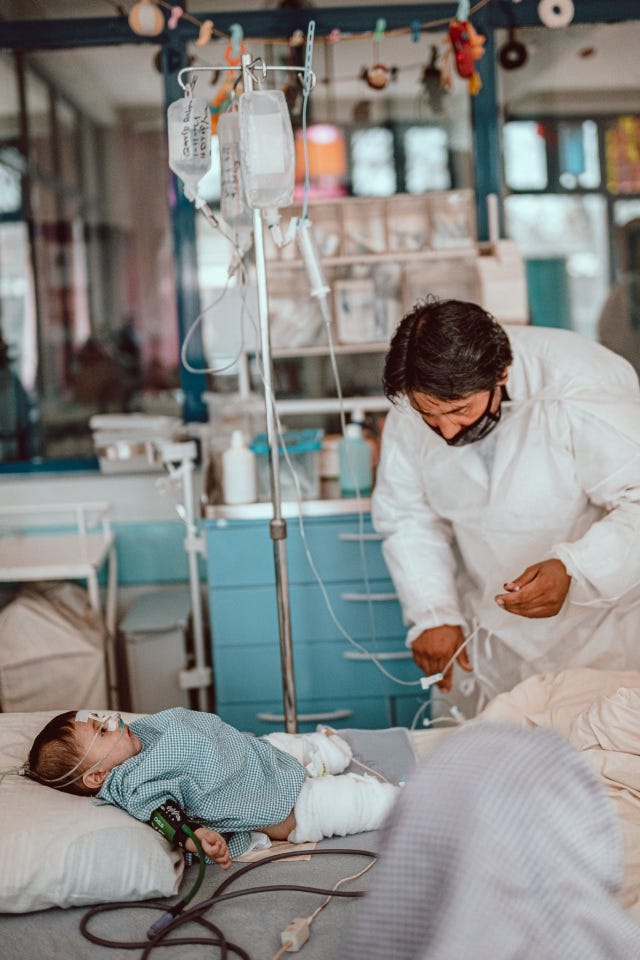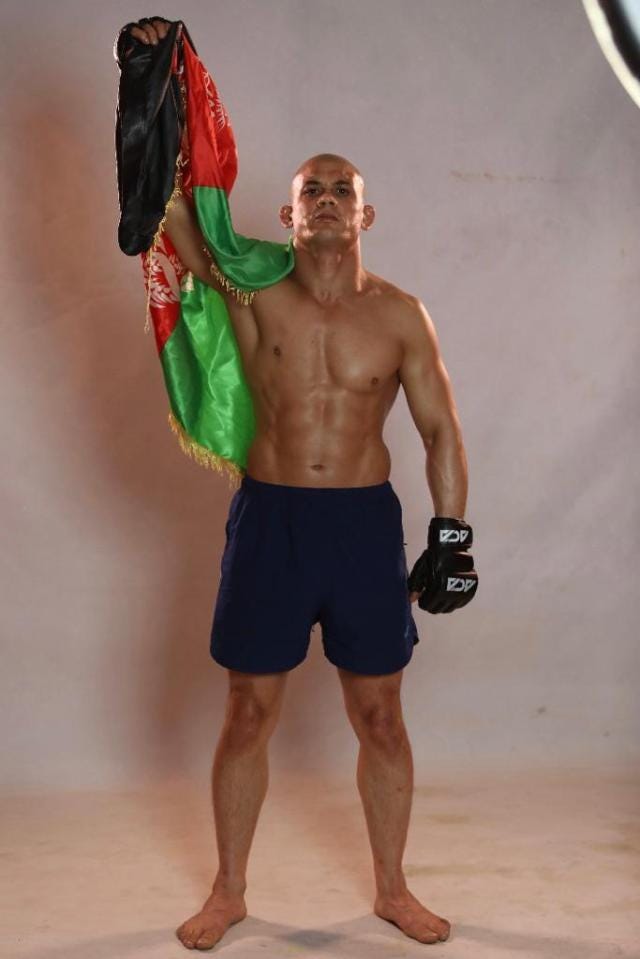“Think you're escaping and run into yourself. Longest way round is the shortest way home.”
― James Joyce, Ulysses
This week was predominated by hospital visits across Kabul. Thanks to the few international donors that have remained, children and victims of war and poverty have some semblance of adequate healthcare, although it is unclear how long such programs will be funded as Afghanistan falls from the twenty-four-hour news cycle.
Nonetheless, I cannot stress what an honor it is to meet the hardworking medical professionals who have devoted their entire lives for years on-end to serve the Afghan people. They are my Hollywood heroes, and I wish everyone knew their name.
One very special person I want to highlight here is Alberto Cairo, the head of the @icrc orthopaedic program in Afghanistan. He arrived on his very first mission from his native Italy in 1990, and refused to ever leave. He truly is an angel on this earth, helping countless Afghans to walk again and bringing quality of life to rising rates of cerebral palsy in the impoverished country.
BIRTH DEFECTS SLATED TO WORSEN AS AFGHANISTAN CRUMBLES INTO ECONOMIC DESPAIR
A baby’s yelps shatter the strange silence inside the Intensive Care Unit of the Irene Salimi Children’s Hospital for Orthopedic Surgery & Pediatric on the dusty edge of Kabul. The little boy – with a tiny body and jarring swollen head calls out in a croaked cry, veins protruding from his scalp and long, thick eyelashes wet with tears.
It is impossible to decipher the infants age, but I learn he is eight months old, and his name is Mohammad. His young mother, baby-faced and bearing the weight of the world on her shoulders, looks on in helplessness.
“He has too much water in the head; it’s a congenital anomaly,” Muhibullah Ahmadzai, Medical Director of the Germany-sponsored hospital, says in halting English. “It’s fairly common in Afghanistan because most women do not fully eat.”
The congenital disability is hydrocephalus, characterized as a condition stemming from an oversupply of cerebrospinal fluid in the brain, resulting in extreme pressure and pain. In the U.S, one in 500 babies is born with such a condition. Still, according to the medical professionals in the war-ravaged Afghanistan, hydrocephalus has become far too familiar amid decades of poverty and conflict.
“During their pregnancy, it is hard for many mothers to supplement with enough iron, so they suffer from extreme deficiency and anemia. For six months in the womb, the babies’ brains are under pressure and then even when they give birth, sometimes they cannot seek the medical help they need right away,” Ahmadzai continues wearily. “Mothers are often malnourished.”
Irene Salimi Children’s Hospital is a rare reprieve in a nation desperately struggling. The state-of-the-art facility – flushed with baby blue walls and lush garden outside – is where the poorest of families from far-flung places come for life-saving pediatric surgery, orthopedics, traumatology, and treatment from severe infections and a wide array of rare congenital anomalies.
Afghanistan has one of the highest infant mortality rates on the planet. And even though it is supposed to be a time of peace in the wake of the U.S. withdrawal, the country is entering another kind of chaos – an economic crisis, in which the healthcare system is one of the hardest-hit components.
“The most important crisis we are now facing are the economic issues. The mothers are not able to feed their children well. Most children need milk, and the families cannot afford to buy the powdered milk,” Ahmadzai says. “Families do not have the money even to treat a child’s fever or cough, so they try to treat with home remedies, and this doesn’t treat infections properly. So they only go to the doctors when the child gets much worse. And in war situations, doctors don’t have a free hand to treat everything.”
The economic and unemployment quagmire also brings with it a string of unintended consequences. Ahmadzai points out that when a person doesn’t have a job to go to, it “automatically affects the person and child abuse increases at the house.”
And the situation, he says, is painfully deteriorating.
Immediately after the Taliban took the helm, Afghans reported dramatic drops in the overall crime rate. Yet steadily, as the financial gloom protracts, unlawful activity is once again ascending across Kabul, Ahmadzai laments.
And it’s almost always the very young who bear the brunt.
AFGHANISTAN’S ELITE MMA FIGHTERS LEFT STRANDED, JOBLESS AND UNABLE TO ESCAPE
While much attention has been given to the deteriorating plight of Afghanistan’s women sports stars in the wake of the Taliban takeover; men too have been left in a lethal limbo amid dashed dreams and shattered livelihoods.
That sentiment is perhaps no more harshly felt than in the country’s once-rising martial arts arena, with some of the top stars now rendered jobless and unable to flee.
“My dreams are destroyed. For the first twenty days (after the Taliban victory), I was locked in my home and did not come out. I was sick for all those days,” says Baz Mohammad Mubariz, one of Afghanistan’s famed Mixed Martial Arts (MMA) fighters, known in the international ring as “The Eagle.” “My daughter is nine years old; now, she cannot go to school. On top of it, my revenue was from the fights, and that was how I could provide for my family. Now, the fights have stopped, and I can’t train here. We don’t have a future, and we’re facing a very uncertain situation.”
MMA, in particular, has amassed a massive following in recent years, with the likes of Mubariz acquiring a cult-like following. I see that for myself sitting outside in a Kabul restaurant garden on a cool autumn afternoon, as scores of young women spot him from afar and giddily line up for selfies and autographs. Mubariz takes it all in his stride as more girls and women hurry over – it’s a rare moment of joy and brevity in a country stuffed with uncertainty and pain.
Now, the Taliban – officially termed the Islamic Emirate of Afghanistan – have made MMA all but impossible with a slew of new policies that ban “face-punching” and mandate that all male athletes must be fully covered.
“We have received many threats, and we’re told (by the Taliban) that we cannot do fights until we have our body fully covered. But we cannot fight properly,” Mubariz laments, adding that earlier this week, they attempted to conduct a fight with one hundred players from different provinces – until the Talibs showed up in the ring. “They slapped (the organizer) and sent everyone back to their homes, and the fight never happened.”
Mubariz says he made three attempts at leaving Afghanistan amid the frenzied U.S. withdrawal, the first time even camping at the gates for more than a day – with a letter from the U.S. government specifying the gate to enter – but could never pass the Taliban and make it onto a flight.
The elite fighter – who is just two fights away from making it to the UFC – notes that he has followed up with emails, all of which have been met with deafening silence.
CLICK TO READ MORE ABOUT STRANDED MARTIAL ARTISTS
U.S. EXIT LEAVES AFGHAN WOMEN’S EDUCATION IN LIMBO DESPITE TALIBAN PROMISES
I have walked through the Ministry of Education – a run-down building with faded white walls and small patches of green rising from cracks in the concrete – multiple times since the Taliban took control of Afghanistan in mid-August. The floors and stuffy office rooms are filled with the new government’s most devout – as evidenced by their long beards and constant twisting of prayer beads – only I am yet to spot a single woman inside the bustling halls or walls.
It’s a searing reminder of the state of girls’ education inside an Afghanistan in limbo, with next to no input from the gender suffering most amid the Taliban takeover.
While boys of all ages were ordered back to classrooms in September, girls’ education after the sixth grade – including some universities – has been indefinitely put on hold. And while private schools continue, the vast majority of Afghan girls and women who rely on the public education system are relegated to the home until further notice.
“Amendments will be made based on our new laws. Islamic scholars will make the decisions,” says Abdul Hakeim, chief of staff for the Minister of Education. “We want an Islamic perspective, and this means separate classes and transport. Once this is sorted out, girls can continue education for a lifetime.”
I have heard such justifications on multiple occasions in recent weeks.
Mawlawi Noor Ahmad Saeed, director of information and culture for Kandahar province – the birthplace of the Taliban – stresses to me that “the whole issue is about transport” and that it will “take time” to make sure girls and women have entirely separate transit and infrastructure facilities.
Nevertheless, the Imam Mawlawi Hayat Khan, who heralds the famed mosque wedged in the primordial village of Sange Saar, of which Mullah Omar started the Taliban movement a quarter of a century ago, stresses that the reason for separation – and why women should cover their whole face except for the eyes – is so that men do not get “too tempted.”
As it stands in Afghanistan, most students do a half-day at regular school and spend the other half intensifying their religious studies in a madrassa.
Yet Hakeim stresses that the country’s dire financial situation means that they urgently need support, not from other governments but non-governmental organizations.
“Other governments want to implement their own mythologies and thinking on the local people,” he says. “We want (schools) to run on our terms.”
Only with each passing day, Afghanistan as a whole dips deeper into poverty. With economic assets frozen and little diplomatic recognition from the outside world, the UN estimates that 97 percent of the 38 million will have plunged into destitution by mid-2022 without urgent action from the outside world.
And needless to say, it is almost always the women and girls who will suffer the haunting repercussions.
As I sit on a floor sipping tea with powerful elder women in Khost, women who speak passionately about the consequential necessity of female teachers and students, one of their small granddaughters – just 9 years old – slips quietly onto the cool concrete. She says nothing, her innocent face staring inquisitively into mine.
She is a child, although for financial reasons, she is engaged to be married.
CLICK TO READ MORE ABOUT WOMEN’S EDUCATION IN AFGHANISTAN
Thanks again for your support.
Follow me on Instagram and Twitter for more updates
Photos courtesy of my brilliant photographer @JakeSimkinPhotos. Please consider a paid subscription to allow us to continue this work.


















Share this post